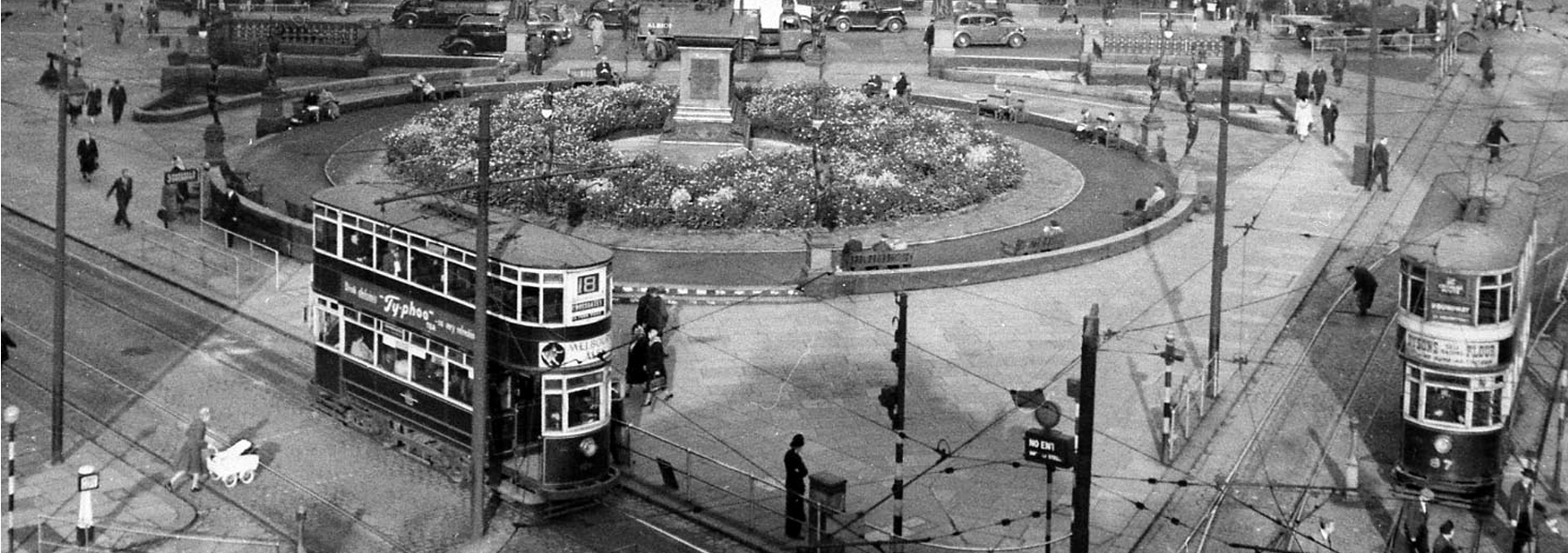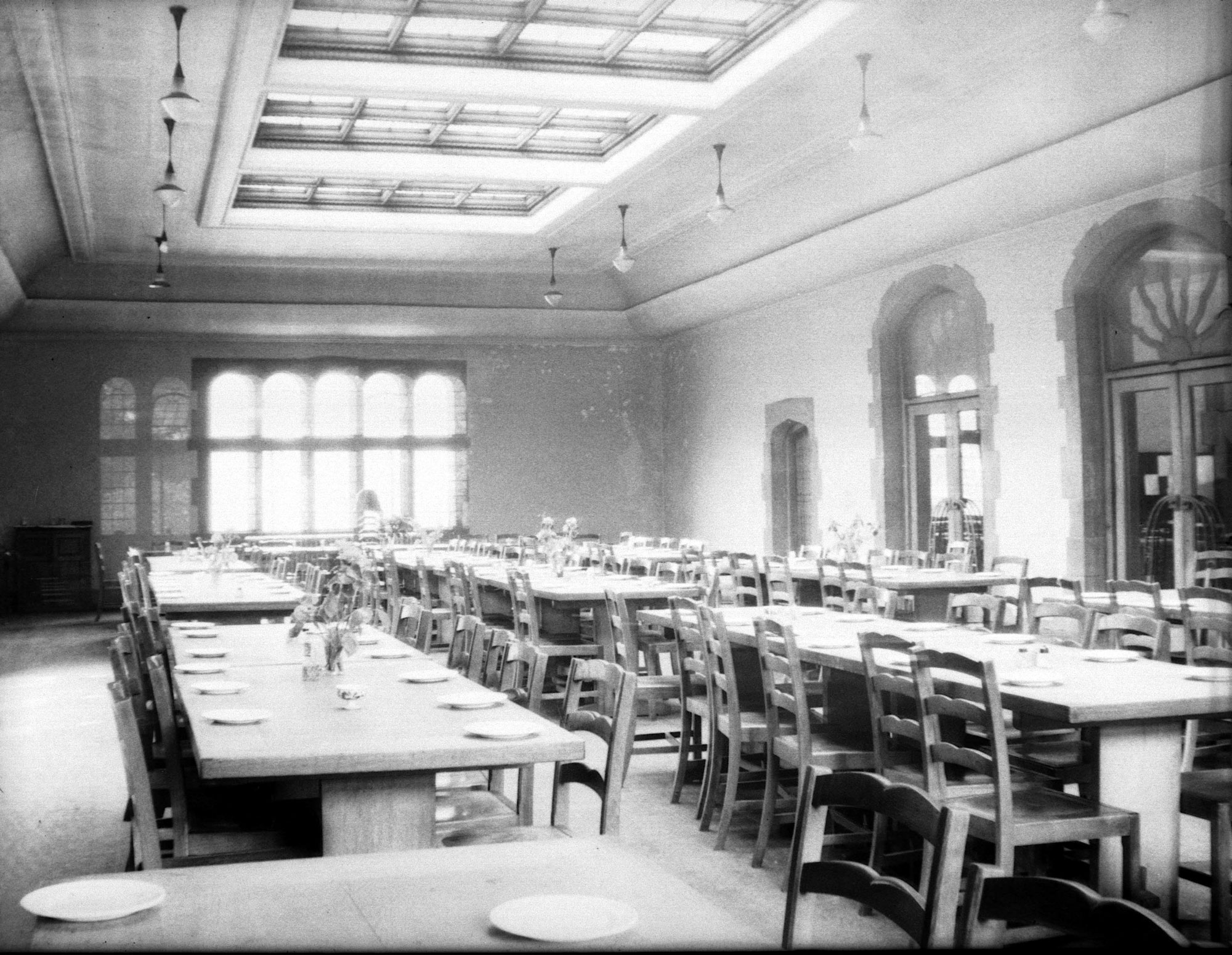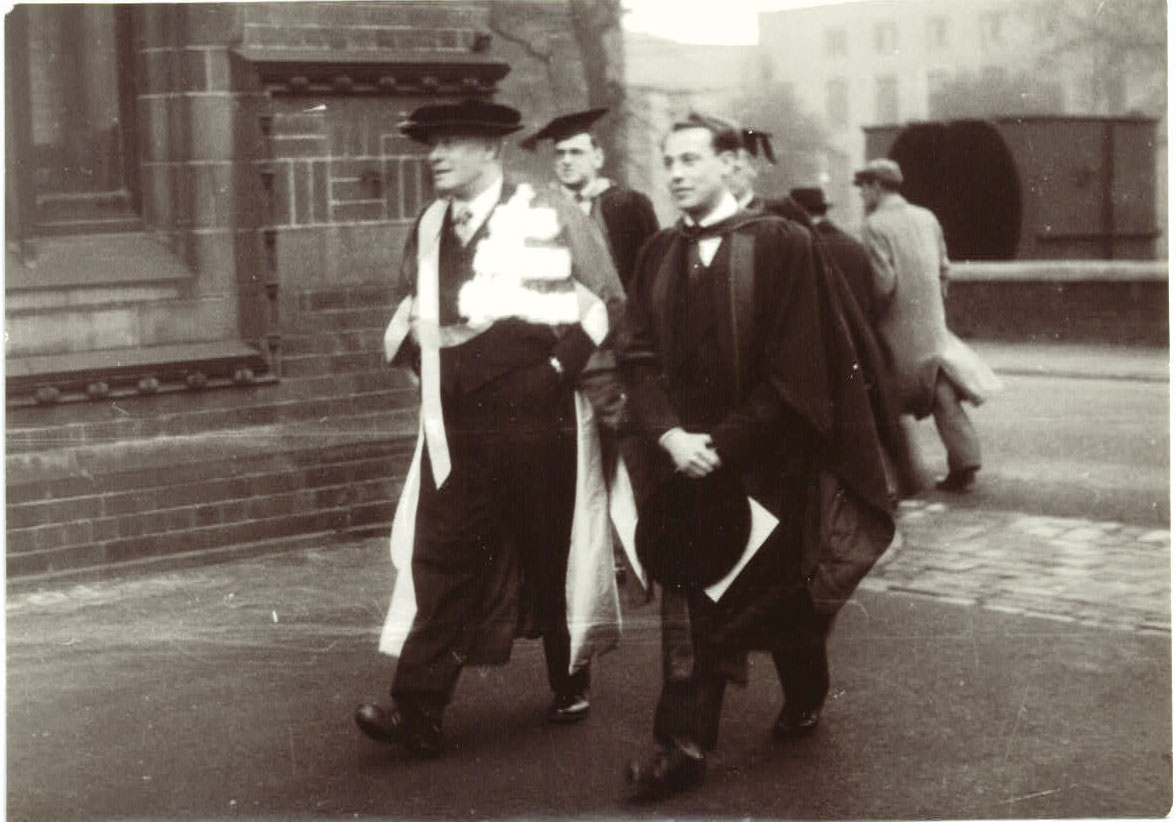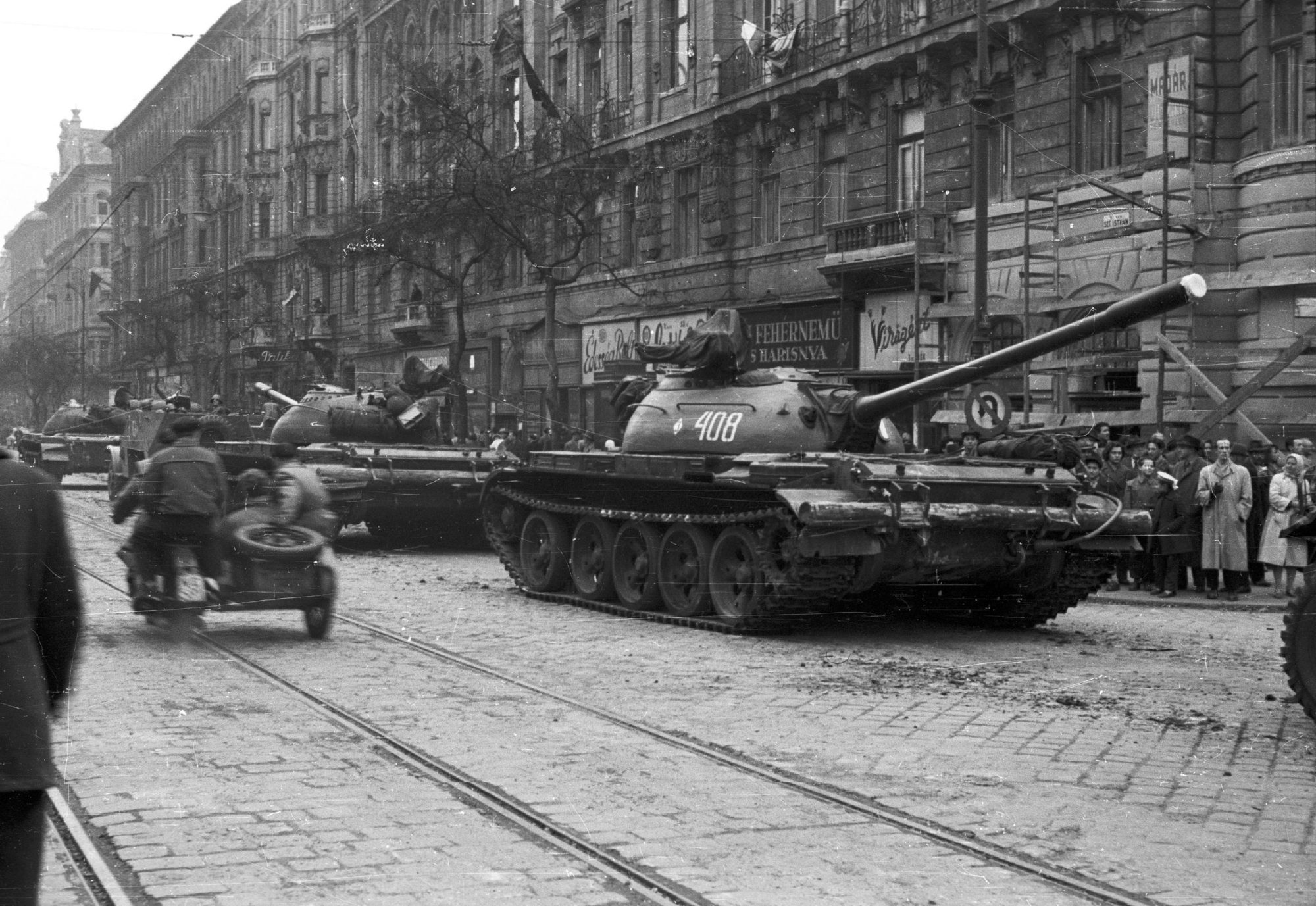



When at Leeds, Laszlo Lorand made a seminal scientific discovery.
But his success came at a heavy personal cost …
Above: Trams in Leeds City Square 1949, perhaps carrying a student clutching precious research supplies to his chest. Credit: The National Archives/SSPL/Getty Images
As a medical student, Laszlo Lorand saw a demonstration that left him amazed. He witnessed blood plasma turn from liquid into a solid clot within a matter of minutes, merely by the addition of a few drops of liquid containing the blood protein thrombin.
This rapid transformation had important life or death implications. While clot formation was essential for healing at sites of injury, if it occurred elsewhere in the body it could result in a fatal thrombosis, or circulatory blockage. Yet despite its physiological importance, how thrombin caused blood to clot remained a mystery, and it was one that Laszlo set out to solve.
Having survived the Holocaust, he joined the Institute of Biochemistry in Budapest in 1946. The Institute was led by the Nobel laureate Albert Szent-Györgyi, who was an inspirational figure to his staff and students.
Szent-Györgyi gave them free tickets to concerts and operas and provided classes in English, which would later prove to be a lifeline for Laszlo.
Lunch in the Institute was followed by fiercely competitive games of volleyball, and regular table tennis matches provided a welcome break from the lab bench. Laszlo was enjoying life at the Institute, but when he received an invitation from the British scientist William Astbury to work with him at Leeds, the opportunity was too good to turn down.
Astbury had carried out pioneering work on the structural changes of blood proteins involved in clot formation, as well as early X-ray studies of DNA. Thanks to his internationally renowned reputation in using X-rays to study the shape of fibrous biological molecules, Astbury’s lab at Leeds was once nicknamed the ‘X-ray Vatican’.
The communist regime in Hungary, however, was far less enthusiastic about Laszlo’s proposed visit to Leeds. As the Cold War began and former wartime allies now became adversaries, the authorities in eastern Europe did not look favourably on their young scientists travelling to the West. In the same year that Laszlo joined the Institute, Winston Churchill made his grim observation that “an iron curtain has descended across the continent”. For Laszlo, that iron curtain was about to come crashing down with full force.
On the afternoon of Friday 17 December 1948, Laszlo was called to a meeting with his supervisor, the biochemist Bruno Straub – who later became the President of Hungary. If Laszlo thought this would be just another routine discussion about his progress in the lab, he could not have been more wrong.
The meeting began well enough with Straub praising Laszlo’s work, but he then demanded that Laszlo give up his plans to travel to England. Straub informed Laszlo that his passport would be withdrawn by the authorities on the following Monday morning.
Having narrowly escaped deportation to Auschwitz where his father had been murdered, Laszlo refused to become the victim of yet another brutal totalitarian regime. That weekend he made a decision that would change his life – and probably broke his heart. On Sunday afternoon he boarded a train bound for Vienna, leaving his widowed mother and the woman he had hoped to marry behind him. He faced the arduous journey with only five pounds sterling in his pocket and, in his suitcase, a freshly roasted goose and a large stick of hard salami – packed by his mother, who feared that Britain was still suffering food shortages.
Once he was safely out of the Communist Bloc, Laszlo paid his way through the ruins of post-war Europe with cigarettes before arriving in London on Boxing Day to stay in what he described as “one of the less lovely hotels near the station”.
On 2 January 1949, Laszlo finally arrived in Leeds where he found that Astbury’s grand vision to establish a new department for molecular biology was starkly at odds with the reality of post-war Britain.
There was no hallowed chapel of science, replete with a state-of-the-art laboratory, here. Laszlo found himself working in a Victorian terrace (now demolished) opposite where the students’ union stands today. It was a converted residential property, plagued with problems. The electricity supply was unreliable, the plumbing was prone to flooding and the floors were so uneven that they made delicate scientific instruments wobble.
It was under these spartan conditions that Laszlo began his research into how thrombin worked. His studies called for regular visits to either a local abattoir or the Red Cross, from which Laszlo would return, sitting on a tram with a bottle of blood clutched tightly to his chest to avoid spilling the precious material needed for his research.
But adverse working conditions were the least of Laszlo’s concerns. Within a year of his arrival in Leeds, he received a letter from Straub instructing him to return to Hungary at once.
To the Communist authorities, the idea that such a promising young scientist as Laszlo could choose of his own volition to remain in the West was an unacceptable loss of face – and one that they were not going to allow.

Laszlo honed his English skills in Devonshire Hall’s dining room.

Two titans of molecular biology – graduation day 1952 for Laszlo Lorand, right, with Prof William Astbury
Astbury was quick to come to Laszlo’s defence and argued to both the University and Hungarian authorities on his behalf. He explained that Laszlo’s work at Leeds was so important that he should be allowed to remain, writing: “As far as I can see, the only ‘crime’ that Lorand has committed is that he was rash enough to leave Hungary to work in this University and has therefore fallen under the bane of western influences. In these days, as you know, that can be sufficient to damn anyone from the eastern European countries, and it appears that it has indeed been sufficient to damn Lorand.”
Although now stripped of his Hungarian citizenship, Laszlo was able to remain in Leeds thanks to Astbury’s intervention. Like many alumni before and after him, he lived in Headingley at the Victorian manor Devonshire Hall – a far lovelier place than his hotel in London had been. The cachet of Laszlo’s Astbury connection secured him a place at the dining room’s high table, a formal setting that brought him not only better food, but also the chance to improve his English.
While at Leeds, Laszlo made the landmark discovery that thrombin acts as an enzyme to convert the soluble blood protein fibrinogen into insoluble fibrin, the active agent of clot formation.
After leaving Leeds to move to the Lister Institute of Preventive Medicine in London, Laszlo made a second major discovery with the isolation of Factor XIII, a blood component that is vital for clot stability and is involved in certain rare hereditary blood disorders. Shortly after, Laszlo moved to the US where he remained until his death in 2018.
He did, however, remain in touch with Astbury. As Soviet tanks rolled through the streets of Budapest during the invasion of Hungary in 1956, Astbury expressed his support for Laszlo and the family he had left behind. Astbury wrote: “We have often thought of you in relation to this horrible business in Budapest … we were very sorry to hear that your own family were unable to escape.”
Laszlo and Astbury shared a love of music, which provided consolation to them in dark times.
In Leeds, the two of them had often enjoyed playing violin duets together, although in a letter of 1957 Laszlo admitted to Astbury that his latest attempts to learn the piano had been far from successful. “I played Auld Lang Syne on New Year’s Eve at midnight,” wrote Laszlo. “Nobody applauded, in fact, I seemed to dampen the merriment.”
Laszlo’s work on clotting would come to be of particular personal significance to Astbury, who suffered from cardiovascular complications during the final years of his life.
Prof Monty Losowsky (Medicine 1955), a former dean of the Leeds School of Medicine, recalled an encounter with Astbury when he was a junior doctor.
Astbury refused to allow him to administer an anticoagulant until Losowsky had first visited the medical library to read the latest papers on the molecular mechanism of clot formation. This was not mere obstinacy on Astbury’s part, but rather he wanted Losowsky to grasp that the future of medicine lay in understanding physiological processes such as clot formation in molecular terms.

Soviet tanks on the streets of Budapest, where Laszlo’s family remained, when revolution came to Hungary in 1956 Credit: FOTO:FORTEPAN / Nagy Gyula
Thanks to Laszlo and his groundbreaking work on fibrinogen and thrombin, Losowsky was able to do just that. He took Astbury’s lesson to heart and went on to play a key role in establishing St James’s University Hospital in Leeds as a renowned centre of teaching and academic research.
Astbury’s vision of molecular medicine, together with Laszlo’s work on clotting, has left a lasting legacy at Leeds in the work of countless researchers such as Losowsky, Robert Ariens and Prof Sir Alex Markham (Hon DSc 2006).
With thrombosis emerging as a serious consequence of Covid-19 infection, Laszlo’s research on clotting remains invaluable to medicine. His discoveries still hold tremendous significance 72 years after the young Hungarian scientist arrived at Leeds, having perforce left his family behind.
Read a previous Leeds magazine feature about William Astbury here.
Words
Dr Kersten Hall (MA History and Philosophy of Science 2008) is a visiting fellow in the School of Philosophy, Religion and History of Science. He corresponded with Prof Laszlo Lorand in the last few years of his life.